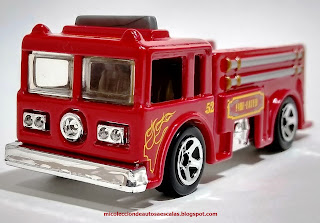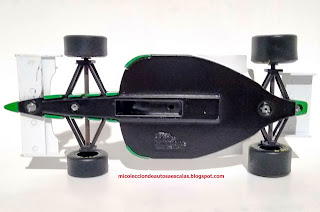Este es un blog de fotografías para la colección personal de autos de diferentes escalas.
Wednesday, October 28, 2009
Wednesday, October 21, 2009
1997 Chevrolet Corvette C5 Hot Wheels 1:64
From Wikipedia:
The Chevrolet Corvette (C5) is the fifth generation of the Chevrolet Corvette sports car, produced by the Chevrolet division of General Motors for the 1997 through 2004 model years. Production variants include the high performance Z06. Racing variants include the C5-R, a 24 Hours of Daytona and 24 Hours of Le Mans GTS/GT1 class winner.
Wednesday, October 14, 2009
1996 Herdez Quaker State Ford #22 Carlos Guerrero Indycar 1:24 F1
Carlos Guerrero (born November 20, 1957, Mexico City, Mexico) is a former driver in the CART Championship Series who was a multiple Formula Three and Formula Two champion in his native Mexico. He raced in the 1995–1996 CART seasons with 17 career starts, including the 1995 Indianapolis 500. He was eliminated in a crash on the first lap, becoming one of a handful of drivers to qualify for only one Indianapolis 500 and fail to complete a lap. His best career finish in CART was 11th position at the 1995 Toyota Grand Prix of Long Beach.
He is not related to race driver Roberto Guerrero.
Wednesday, October 7, 2009
1973 Volkswagen Beetle Sedan Fusca Maisto 1:24
In 1970, A new "L" (Luxus) Package was introduced including, among other items, twin map pockets, dual rear ashtrays, full carpeting, a passenger-side visor vanity mirror, and rubber bumper moldings. The optional 1500 cc engine now came with an engine lid having two rows of cooling louvers, while the convertible's engine lid gained two additional sets for a total of four. For North America, the 1500 cc engine was enlarged to 1600 cc engine and produced 57 hp (43 kW; 58 PS)
For 1971, for the first time there were two Beetles, the familiar standard Beetle and a new larger version that was different from the windscreen forward. All Beetles received an engine upgrade: the optional 1500 cc engine was replaced by a 1600 cc version with twin-port cylinder heads and a larger, relocated oil cooler. The new engine produced 60 hp (45 kW; 61 PS). The ventilation system was improved with the original dash-top vents augmented by a second pair aimed directly at the driver and passenger. For the first time the system was a flow-through design with crescent-shaped air exits fitted behind the rear quarter windows. Airflow could be increased via an optional 2-speed fan. The standard Beetle was now badged as the VW 1300; when equipped with the 1600 engine, it was badged 1300 S, to avoided confusion with the Type 3, which wore VW 1600 badges.
The new larger Beetle was sold as the 1302/1302 S. The sole purpose of the big Beetle was to provide increased luggage capacity, which grew 50%. A new MacPherson strut front suspension was incorporated, similar to what was used in the Type 4, and the front track was widened. The new suspension layout allowed the spare tire to be positioned flat under the trunk floor, although the car had to be lengthened slightly to accomplish this. This also allowed a reduction in turning radius. To gain additional trunk volume, the under-dash panel was lowered, allowing the fuel tank to be shifted rearward. From the windscreen back the big Beetle was identical to its smaller progenitor, except for having the semi-trailing arm rear suspension as standard equipment. Overall, the big Beetle was 50 mm (2.0 in) longer in length and 35 mm (1.4 in) wider and rode on a 20 mm (0.79 in) longer wheelbase than the standard model. Both Beetles were available with or without the L Package. The convertible was now based on the 1302 body. In North America, the 1302 was marketed as the Super Beetle and came only with the L Package and 1600 cc engine. While it lacked the front disc brakes that normally accompanied the larger motor, it was fitted with brake drums that were slightly larger than the standard Beetle. With the Super Beetle being sold as the premium model in North America, the standard Beetle, while retaining the same 1600 cc engine, was stripped of many of its earlier features in order to reduce the selling price. Bright window and running board moldings disappeared, along with the day/night mirror, horn ring, map pocket, locking glove box and miscellaneous other items.
1972 models had an 11% larger rear window (40 mm (1.6 in) taller), larger front brakes and the convertible engine lid with four rows of louvres was now used on all Beetles. Inside the vehicle, a four-spoke energy-absorbing steering wheel was introduced, the windshield wiper/washer knob was replaced in favor of a steering column stalk, and intermittent wipers were a new option available in selected markets. An engine compartment socket for the proprietary VW Diagnosis system was also introduced. The rear luggage area was fitted with a folding parcel shelf. A limited-edition Commemorative model was launched in celebration of the Beetle's passing the record of the Ford Model T as the world's most-produced automobile.[53] The Commemorative Beetle was a 1302 LS finished in a special Marathon Blue Metallic paint and unique 4.5 x 15 styled steel wheels. In the U.S., it was marketed as the Super Beetle Baja Champion SE.
1973 models featured significantly-enlarged "elephant foot" taillamps mounted in reshaped rear fenders. In the engine bay, the oil-bath air cleaner gave way to a dry element filter, and the generator was replaced with an alternator. The 1302/Super became the 1303 with a new taller wrap-around windscreen. The changes to the cowl and windshield resulted in slight redesign of the front hood. The instrument panel, formerly shared with the standard Beetle, was all-new and incorporated a raised speedometer pod, rocker-style switches and side-window defrosters. The limited-edition GSR (Gelb-Schwarz Rennen) was a 1303 S available only in Saturn Yellow paint equipped with special 5.5 in (140 mm) wide sport wheels fitted with 175/70-15 Pirelli Cinturato CN36 high-performance radial tires. Front and rear deck lids were finished in matte black, as was all exterior trim with the exception of the chrome headlamp bezels. Inside were corduroy and leatherette high-bolstered sport seats and a small diameter three-spoke steering wheel with padded leather rim and a small red VW logo on the bottom spoke. In North America, the GSR was sold as the Super Beetle Sports Bug. The North American model had body-color deck lids and was available in Marathon Blue Metallic in addition to Saturn Yellow. In some markets, the sport wheels (in both 4.5-inch and 5.5-inch widths), sport steering wheel and sport seats became available as stand-alone options.
For 1974, North American models received newly required 5 mph (8.0 km/h) impact bumpers mounted on self-restoring energy absorbers, which added approximately (25 mm (0.98 in) to the car's overall length. On the Super Beetle, the steering knuckle, and consequently the lower attachment point of the strut, was redesigned to improve handling and stability in the event of a tire blowout. A limited-edition Big Beetle was introduced based on the 1303 LS. Available in unique metallic paint colors, the car featured styled-steel 5.5 in (140 mm) wide sport wheels wrapped in 175/70-15 tires, corduroy seat inserts, upgraded loop-pile carpet, wood-look instrument panel trim and a padded steering wheel with bright accents. In the North American market, a limited-edition Sun Bug was introduced as a standard Beetle or Super Beetle. Both were finished in metallic gold and featured styled-steel 4.5 in (110 mm)-wide sport wheels. Inside were brown corduroy and leatherette seats, loop-pile carpet, and padded four-spoke deluxe steering wheel. The Super Beetle Sun Bug included a sliding-steel sunroof.
In 1975, front turn indicators were moved from the top of the front fenders down into the bumper. At the rear, the license plate light housing was now molded of plastic with a ribbed top surface. To comply with tightening emission standards, the 1600 cc engine in Japanese and North American markets received Bosch L-Jetronic fuel injection, a derivative of the Bosch D-Jetronic system formerly used in the VW Type 3 and Type 4. The injected engine received a new muffler and in California a catalytic converter. This necessitated a bulge in the rear apron under the rear bumper and replaced the distinctive twin "pea shooter" tailpipes with a single offset pipe, making injected models identifiable at a glance. 5 mph (8.0 km/h) bumper-equipped North American models retained fender-top front indicators. The 1303 received rack and pinion steering. In North America, the 1303/Super Beetle sedan was moved upmarket and was now christened La Grande Bug. Similar to the Big Beetle of 1974, La Grande Bug was available in blue or green metallic paint in the U.S. and blue, green or gold metallic in Canada and was equipped with the same features as the 1974 Sun Bug. Mid-year, the Love Bug was introduced for North America: based on the standard Beetle, it was available only in Phoenix Red or Ravenna Green (both colors shared with the VW-Porsche 914) with all exterior trim finished in matte black. A price leader, the Love Bug retailed for less than a standard Beetle. The "Volkswagen" script on the engine lid of all North American Beetles was replaced with a "Fuel Injection" badge.
In 1976, the 1303/La Grande Bug was discontinued, with the larger body continuing only in convertible form. To make up for the loss in North American markets, the standard Beetle was upgraded, regaining some of the features that were removed in 1971. In addition, the 2-speed ventilation fan was included, previously available in North America only on the larger Beetle. The automatic stickshift option was discontinued as well.
1977 models received new front seats with separate head restraints. This was the final model year for the Beetle sedan in North America. The convertible was offered in a Champagne Edition in triple white with the padded deluxe steering wheel, burled elm-grain dash trim and 4.5 in (110 mm) wide sport wheels. Approximately 1,000 Champagne Editions were produced.
For 1978, a new Champagne Edition convertible was launched, available in blue or red metallic paint with white leatherette interior. Features included the 4.5 in (110 mm) wide styled steel sport wheels, AM/FM radio, analog quartz clock, padded deluxe steering wheel and rosewood-grain instrument panel trim. Approximately 1,100 were produced.
In 1979, VW offered an Epilogue Edition of the convertible in triple black with features similar to the 1978 Champagne Edition. This would be the last year of convertible production worldwide as well as the final year for the Beetle in North America.
Subscribe to:
Posts (Atom)







































